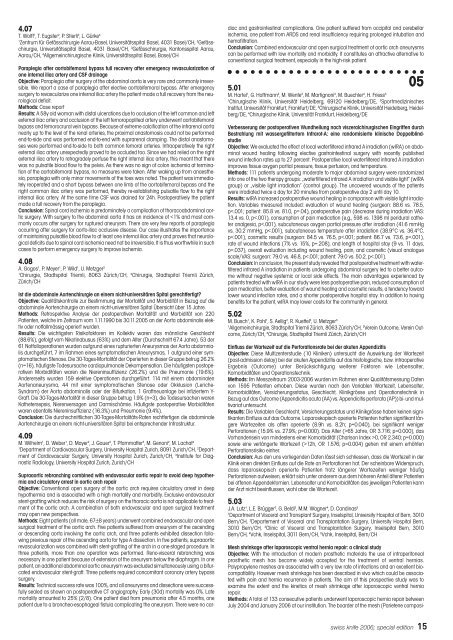Abstracts 4. Gemeinsamer Jahreskongress der ... - SWISS KNIFE
Abstracts 4. Gemeinsamer Jahreskongress der ... - SWISS KNIFE
Abstracts 4. Gemeinsamer Jahreskongress der ... - SWISS KNIFE
Create successful ePaper yourself
Turn your PDF publications into a flip-book with our unique Google optimized e-Paper software.
swissknife spezial 06 12.06.2006 13:39 Uhr Seite 15<br />
<strong>4.</strong>07<br />
T. Wolff 1 , T. Eugster 2 , P. Stierli 3 , L. Gürke 4<br />
1 Zentrum für Gefässchirurgie Aarau-Basel, Universitätsspital Basel, 4031 Basel/CH, 2 Gefässchirurgie,<br />
Universitätsspital Basel, 4031 Basel/CH, 3 Gefässchirurgie, Kantonsspital Aarau,<br />
Aarau/CH, 4 Allgemeinchirurgische Klinik, Universitätsspital Basel, Basel/CH<br />
Paraplegia after aortobifemoral bypass full recovery after emergency revascularization of<br />
one internal iliac artery and CSF drainage<br />
Objective: Paraplegia after surgery of the abdominal aorta is very rare and commonly irreversible.<br />
We report a case of paraplegia after elective aortobifemoral bypass. After emergency<br />
surgery to revascularize one internal iliac artery the patient made a full recovery from the neurological<br />
deficit.<br />
Methods: Case report<br />
Results: A 58y old woman with distal ulcerations due to occlusion of the left common and left<br />
external iliac artery and occlusion of the left femoropopliteal artery un<strong>der</strong>went aortobifemoral<br />
bypass and femorocrural vein bypass. Because of extreme calcification of the infrarenal aorta<br />
nearly up to the level of the renal arteries, the proximal anastomosis could not be performed<br />
end-to-side and was performed end-to-end with suprarenal clamping. The distal anastomoses<br />
were performed end-to-side to both common femoral arteries. Intraoperatively the right<br />
external iliac artery unexpectedly proved to be occluded too. Since we had relied on the right<br />
external iliac artery to retrogradely perfuse the right internal iliac artery, this meant that there<br />
was no pulsatile blood flow to the pelvis. As there was no sign of colon ischemia at termination<br />
of the aortobifemoral bypass, no measures were taken. After waking up from anaesthesia,<br />
paraplegia with only minor movements of the toes was noted. The patient was immediately<br />
reoperated and a short bypass between one limb of the aortobifemoral bypass and the<br />
right common iliac artery was performed, thereby re-establishing pulsatile flow to the right<br />
internal iliac artery. At the same time CSF was drained for 24h. Postoperatively the patient<br />
made a full recovery from the paraplegia.<br />
Conclusion: Spinal cord ischemia is predominately a complication of thoracoabdominal aortic<br />
surgery. With surgery to the abdominal aorta it has an incidence of
















